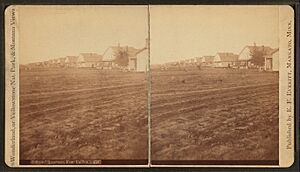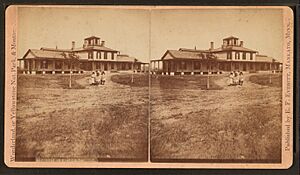Fort Custer (Montana) facts for kids
Quick facts for kids Fort Custer |
|
|---|---|
| Crow Indian Reservation, Big Horn County, about 1 mile west of I-90 and 2 miles southeast of Hardin, Montana | |
| Site information | |
| Controlled by | United States |
| Site history | |
| Built | 1877 |
| In use | 1877–1898 |
| Battles/wars | Indian Wars |
| Garrison information | |
| Past commanders |
|
| Garrison | |
Fort Custer was an important military base built by the U.S. Army in 1877. It was located near what is now Hardin, Montana, on the Crow Indian Reservation. The fort was named after General George Armstrong Custer, who had died a year earlier at the Battle of the Little Bighorn. Soldiers at Fort Custer helped keep peace and manage relations with Native American tribes like the Sioux, Cheyenne, and Crow Indians during a time of many changes in the American West.
Contents
Building Fort Custer
In the spring of 1877, the U.S. Army decided to build a new fort. Soldiers from different companies, along with skilled workers, traveled to the Little Bighorn area in Montana. Their mission was to construct Fort Custer.
Lieutenant-Colonel George P. Buell of the 11th Infantry was in charge of the building project. He and his team faced challenges, including slow boats and difficult travel. They finally reached the site in June 1877.
The plan was to build the fort using materials found nearby. So, the soldiers and workers started cutting down trees, making bricks, and sawing lumber. Most of the buildings were made from cottonwood trees. The walls were built by stacking thick planks of wood flat on top of each other, making them six inches thick.
The fort was built on a high, flat area where two rivers met. Colonel Buell chose this spot because it was a great location, and his choice was later approved. Even with delays, the fort was ready enough to shelter the soldiers and their supplies for the winter.
Fort Custer was designed to house ten companies of soldiers, including stables for six groups of cavalry horses. The buildings were arranged around a large parade ground. Unlike some forts, it did not have tall walls or other strong defenses.
How Fort Custer Got Its Name
When it was first built, Fort Custer didn't have an official name. It was simply called "Post No. 2 on the Bighorn River."
On July 4, 1877, Lieutenant-Colonel G. P. Buell, who was commanding the post, announced that it would be known as "Big Horn Post" until a permanent name was chosen. He also set up a large military area around the fort.
Later that year, important generals like Philip Sheridan and George Crook discussed what to name the new forts. General William Tecumseh Sherman suggested naming one of the forts "Custer." However, General Alfred Terry was not keen on honoring General Custer in this way.
Despite some disagreements, the fort was officially named Fort Custer. This happened on November 8, 1877, by order of the Army Headquarters.
Fort Custer's Story
Most Native American tribes in the area were already living on reservations when Fort Custer was built. In November 1877, the Second Cavalry and the 11th Infantry were among the first troops stationed there. The fort played a role in various military actions, including the Bannock War.
Exploring the Custer Battlefield
Fort Custer was close to the site of the Little Bighorn Battlefield. In April 1879, Captain George K. Sanderson from Fort Custer was sent to the battlefield. His job was to clean up the area and rebury any remains that had become uncovered.
Later, in January 1881, Lieutenant Charles F. Roe and his cavalry troop left Fort Custer. They were heading to the battlefield to deliver materials for a monument. This monument was built to honor the soldiers who had died in the famous battle.
The First Cavalry Arrives
In 1884, the First Cavalry took over from the Second Cavalry at Fort Custer. Other infantry units also joined them.
The U.S. Army was also asked to help manage Yellowstone National Park. In 1886, soldiers from Fort Custer, specifically Company M of the First United States Cavalry, went to Yellowstone. This marked the start of over 30 years of military presence in the park.
In the fall of 1887, there was an incident at the Crow Agency. Colonel Nathan Dudley and several troops from Fort Custer were sent to deal with the situation. They went to arrest a Native American leader named "Sword Bearer" and others.
By April 1892, the First Cavalry, led by Colonel A. K. Arnold, left Fort Custer.
The Buffalo Soldiers at Fort Custer
On May 5, 1892, the Tenth Cavalry arrived at Fort Custer. This regiment was famous for its "Buffalo Soldiers." This nickname was given to African-American cavalry soldiers by Native American tribes they encountered. The term eventually became known for all African-American regiments formed after 1866.
Fort Custer closed on April 17, 1898. The Tenth Cavalry and other units stationed there were sent to Fort William Henry Harrison near Helena. The buildings of Fort Custer were sold and used to help build the nearby town of Hardin, Montana.
Today, a marker placed by the Daughters of the American Revolution shows where the fort once stood. It's on the Crow Indian Reservation, on what used to be a golf course. All that remains are some scattered cellars and dips in the ground. You can find it near I-90, south of Hardin, where the highway crosses the Big Horn River.
A small part of the fort's history lives on in Fort Smith, Montana. There, a building that was once part of the fort is now a Bed and breakfast run by the Crow Indians. Also, the Bighorn County Historical Museum has a replica of the fort.





